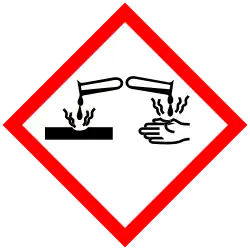Glyphosine
 | |
| Names | |
|---|---|
| Preferred IUPAC name
N,N-bis(phosphonomethyl)glycine | |
| Identifiers | |
3D model (JSmol)
|
|
| ChEBI | |
| ChEMBL | |
| ChemSpider | |
| ECHA InfoCard | 100.017.699 |
| EC Number |
|
| KEGG | |
PubChem CID
|
|
| UNII | |
CompTox Dashboard (EPA)
|
|
| |
| |
| Properties | |
| C4H11NO8P2 | |
| Molar mass | 263.079 g·mol−1 |
| Appearance | Colourless solid[1] |
| 350 g/L[1] | |
| Hazards | |
| Occupational safety and health (OHS/OSH): | |
Main hazards
|
danger |
| GHS labelling:[1] | |

| |
| Warning | |
| H318 | |
| P264+P265, P280, P305+P354+P338, P317 | |
| Lethal dose or concentration (LD, LC): | |
LD50 (median dose)
|
3925 mg/kg (rat, oral)[2] |
Except where otherwise noted, data are given for materials in their standard state (at 25 °C [77 °F], 100 kPa).
Infobox references
| |
Glyphosine is a plant growth regulator used on sugar beet and sugarcane. It inhibits fiber production, causing the plant to divert more dry matter to sucrose storage.[1] 76,000 pounds (34,000 kg) of glyphosine were used in the US in 1974.[3] It was first registered in 1972, though now is considered largely obsolete.[1] In other plants, e.g. maize, it causes chlorosis by inhibiting plasmid RNA synthesis.[4] It can be synthesized from chloroacetic acid and N,N-bis(phosphonomethyl)amine.[5] Metals form complexes with glyphosine.[6][7]
Chemically, glyphosine is a tertiary amine, a glycine derivative and a phosphonic acid.[2]
It has been manufactured by CCA Biochemical and Monsanto, and sold under the "Polaris" trademark.[1]
References
- ^ a b c d e Lewis, K.A., Tzilivakis, J., Warner, D. and Green, A. (2016) An international database for pesticide risk assessments and management. Human and Ecological Risk Assessment: An International Journal, 22(4), 1050-1064. DOI: 10.1080/10807039.2015.1133242
- ^ a b "Glyphosine". pubchem.ncbi.nlm.nih.gov.
- ^ "Pesticide Usage Survey of Agricultural, Governmental, and Industrial Sectors in the United States, 1974". epa.gov. EPA. 1977.
- ^ Slovin, Janet P.; Tobin, Elaine M. (12 August 1981). "Glyphosine, a plant growth regulator, affects chloroplast membrane proteins". Biochimica et Biophysica Acta (BBA) - Bioenergetics. 637 (1): 177–184. doi:10.1016/0005-2728(81)90224-3.
- ^ "n2:0044-460X - Search Results". search.worldcat.org. Retrieved 2024-11-21.
- ^ Xuebing, Ma; Xiangkai, Fu (2004-02-02). "Synthesis of the novel layered amorphous and crystalline zirconium phosphate–phosphonates Zr(HPO4)[O3PCH2N(CH2CH2)2O]·nH2O, Zr(HPO4)[O3PCH2N(CH2CO2H)2]·nH2O, zirconium phosphonates Zr[(O3PCH2)NCH2CO2H]·nH2O and the catalytic activities of their palladium complexes in hydrogenation". Journal of Molecular Catalysis A: Chemical. 208 (1): 129–133. doi:10.1016/j.molcata.2003.07.004. ISSN 1381-1169.
- ^ Galanski, Mathea Sophia; Slaby, Susanna; Jakupec, Michael A.; Keppler, Bernhard K. (2003-11-06). "Synthesis, Characterization, and in Vitro Antitumor Activity of Osteotropic Diam(m)ineplatinum(II) Complexes Bearing a N , N -Bis(phosphonomethyl)glycine Ligand". Journal of Medicinal Chemistry. 46 (23): 4946–4951. doi:10.1021/jm0308040. ISSN 0022-2623. PMID 14584945.
Links
- Glyphosine in the Pesticide Properties DataBase (PPDB)